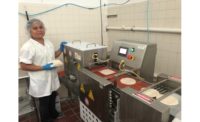By: Peter Dreßler, head of sales for bar production at Bosch Packaging Technology
Bar production is changing in response to three major developments. The most significant one is the eating ‘on the go’ trend. As the pace of life accelerates, people try to juggle an increasing number of commitments related to work, family, and leisure time. Consequently, snacks—including bars—have an increasingly important role to play in this kind of lifestyle. Consumers keep them on hand throughout the day, and they sometimes replace actual meals. As such, consumers no longer simply desire traditional chocolate bars, but seek out healthy alternatives such as grain-based or sugar-free bars. The second development is the growing shift in consumption towards healthy bars and/or bars that are “free from” a certain ingredient. This has of course always been important for customers with nut or gluten allergies, but today’s wide range of “free from” products signals that this trend has gone mainstream. Increasingly, bars contain ‘healthy grains’ like chia seeds or are labelled gluten-free, which makes them easier to digest and offers a healthy alternative to wheat and rye. Bars are healthier and more popular than ever, with supermarket shelves boasting a large selection. But rising popularity and increased variety are not the only observable trends: Bars are now being produced in different sizes, too. Combined, these three developments create new challenges for bar production.
Changing market demands require increased flexibility and hygienic design
Manufacturers can respond to these market trends by upgrading their equipment, for example by choosing a complete bar production solution that coordinates each and every production process. In any event, bar production must prevent cross-contamination when product changeovers occur. This can be done by ensuring the production lines are designed with hygiene in mind. Integrated quick-release systems facilitate easy access for operators, without requiring tools for maintenance and cleaning. Cleaning dirty machine parts must be possible at any time during production. Special surface coatings or easy-to-manipulate scrapers can also stop material build-up on machine surfaces. A well thought out design can play a major part in ensuring compliance with the food industry’s strict hygiene regulations.
To ensure production processes are efficient, every component of bar production, from dosage through to cooling, needs to be flexible and enable fast product changeovers. achine parts can be adjusted or removed without tools, for example movable fanning systems that fan out the bars and guarantee quick format changes. Coupled with an intuitive user interface, productivity and product quality can be boosted significantly.
Product recalls on the rise
The year 2015 recorded an increase in foodstuff recalls by 78 percent compared to 2014 according to the UK Food Standards Agency (FSA). Out of 159 recalls, most cases that year related to failures to list ingredients, with 63 cases involving nutritional issues and 96 involving allergies. Manufacturers had to recall products that contain allergens such as nuts, milk, and gluten, as well as products that contained bacteria, such as salmonella, or even traces of metal. Given the significant increase in these figures, the FSA called for manufacturers and suppliers to take immediate action. For this reason, hygienic design—from a manufacturing perspective—is crucial in terms of product safety for consumers and brand safety for manufacturers considering how costly recalls can be.
Single Source Solutions minimize waste and maximize productivity
Production lines should be geared towards long production cycles and uniform quality. Manufacturers no longer just produce traditional chocolate bars, but also make muesli, granola, and cereal bars; bars containing fruit, coconut, or a combination of nougat and caramel; brittle bars; and bars with multiple layers. Quality consistency is a must given the wide selection of products. Unsurprisingly, mixing ratios need to be standardized. Gentle handling is also important in order to prevent product damage, particularly when working with flaky ingredients. Furthermore, the equipment needs to ensure consistent mixing quality, even when different volumes are being processed.
Manufacturers can boost productivity and efficiency by minimizing waste, most of which occurs during the shaping phase. With the help of new technologies, edge cutting—also known as trimming—can even be eliminated completely. Once the material has been shaped, trimmed and pre-cooled, the slab is then cut to size. Again, with a view to preventing waste, manufacturers can opt for ultrasonic sealing technology, which exerts very little pressure on the bars and thereby ensures quality.
Using different machines during production can be problematic in terms of interfaces. Compatibility issues between individual components not only lead to delays when trying to integrate processes, but also have an adverse effect on the productivity of a line. From a manufacturer's perspective, every second counts. Coordinating the individual processes from mixing, shaping, pre-cooling, crosswise cutting, and fanning out through to lengthwise cutting, covering, and final cooling saves time and money in the long run. In order to keep up with changing market demands and to remain competitive, systems therefore should be designed with high output levels in mind. A fully integrated line—if possible even going beyond production to incorporate primary and secondary packaging—ensures maximum effectiveness for the system as a whole.












